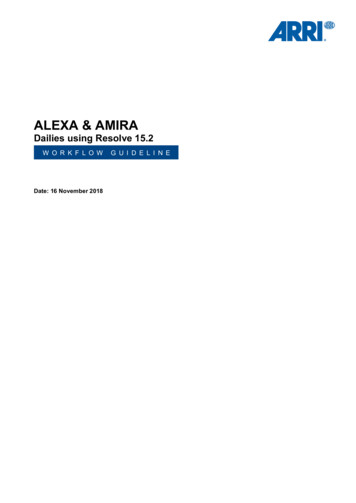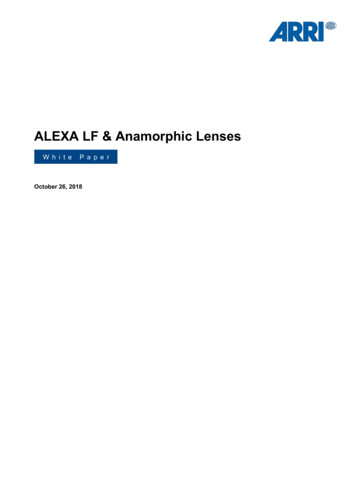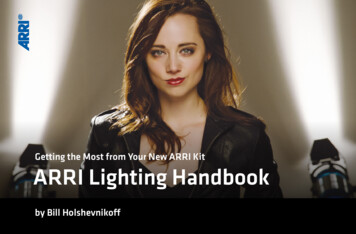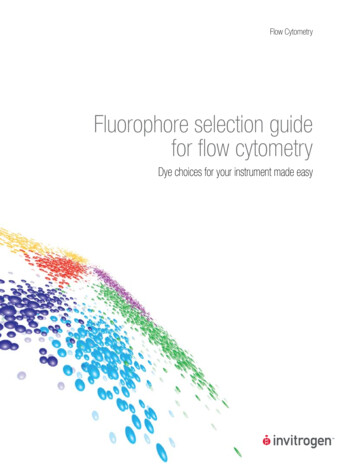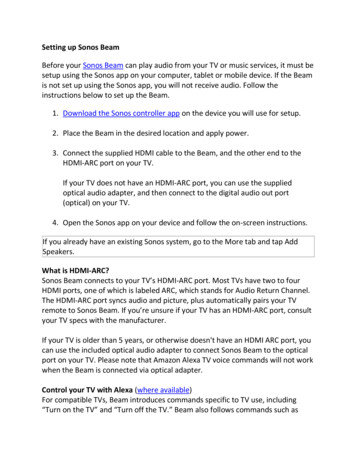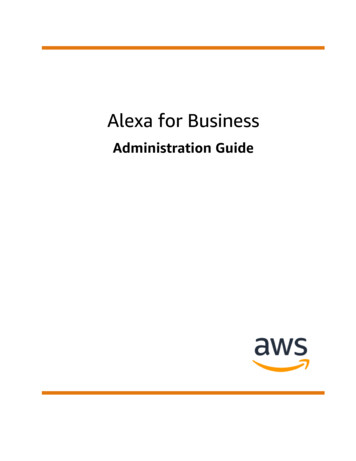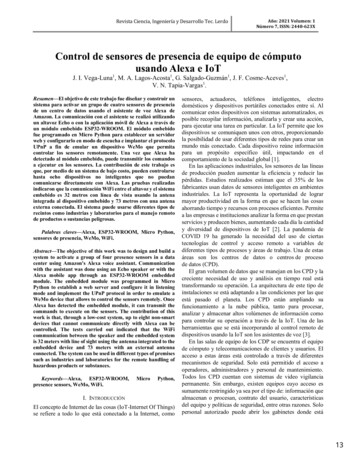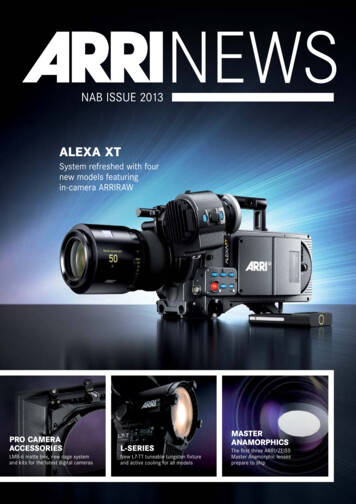
Transcription
NAB ISSUE 2013NEWSALEXA XTSystem refreshed with fournew models featuringin-camera ARRIRAWPRO CAMERAACCESSORIESLMB-6 matte box, new cage systemand kits for the latest digital camerasL-SERIESNew L7-TT tuneable tungsten fixtureand active cooling for all modelsMASTERANAMORPHICSThe first three ARRI/ZEISSMaster Anamorphic lensesprepare to ship
EDITORIALDEAR FRIENDS AND COLLEAGUES2013 got off to a great startwhen the National Academy ofTelevision Arts & Sciences honoredus in January with a Technologyand Engineering Emmy for ourwork with large format CMOSsensors. Awards season swiftly followed, withmany of the top prizes going to productions thatworked with ARRI equipment. For the second yearrunning, a film captured with ALEXA won both thecinematography and VFX Oscars (Life of Pi), while70% of all Oscars for live-action features went tofilms shot with ARRI cameras.We’re excited to be promoting our new ALEXA XTcameras at NAB. It is too easy, amid all the hypesurrounding 4K, to lose sight of the fact thatoverall image quality is a delicate balance of manydifferent factors, of which spatial resolution is justone. We know that our approach results in imagesthat are of the highest possible quality today, andthat are safe for tomorrow; top filmmakers usingALEXA know it too. Almost all major feature filmsare currently postproduced and distributed in 2K,18but ARRIRAW allows working at ahigher resolution through post, aroute taken by Skyfall in preparationfor its successful IMAX release.When 4K is truly ready, we will be too.In the pages of this issue youwill find details of our other camera developments,as well as exciting new lighting and DI products.A fuller picture can be gleaned at our revampedshow page – arri.com/nab2013 – where allmaterials are gathered together and new videosfrom the show floor will be uploaded every day.Going into NAB we are desperately sad to bemourning the loss of our good friend and colleagueBill Lovell, who as Head of 3D and Digital at ARRIMedia was a key figure in our work with digitalimaging. His absence at this year’s show will bepalpable.Dr. Martin Prillmann16Claudio Miranda, ASCPhoto: Michael Yada A.M.P.A.S 8Franz KrausCONTENTSCAMERA2 ARRINEWS4Roberto Schaefer, ASC, AIC, discusses The Host6ARRI/ZEISS Master Anamorphic lens test shoot141.4x and 2.0x Alura Zoom extenders announced16Productions using ARRI cameras win big awards18New ALEXA XT cameras prove a global hit20ALEXA upgrades and accessories24Gabriel Beristain, ASC, BSC, shoots Magic City26ARRI Pro Camera Accessories for Sony F5/F5528New Lightweight Matte Box LMB-630Latest Pro Camera Accessory developments32ALEXA Fiber Remote Option shoots music gigsLIGHTING68Gaffer Cory Geryak anticipatesthe ARRI M9022ARRI L7 LED Fresnels turn BBCstudio green34New L-Series L7-TT and activecooling optionsDI SYSTEMS10NFB tests ARRISCAN archivetools on old 16 mm films34CONTACTS30ARRINEWS 3
THE HOST“In the DI suite, I didn’tneed to do as muchdefocusing, softening,and contrast reductionas I might have had towith another camera.”Roberto Schaefer, ASC, AIC,shoots his first feature with theARRI ALEXAThe Host is the latest film from the visually inventive mind ofNew Zealand-born director Andrew Niccol, whose credits includeGattaca and Lord of War. Won over by working with the ARRI ALEXAon his previous feature, In Time, Niccol suggested using it again tohis cinematographer on The Host, Roberto Schaefer, ASC, AIC.Schaefer has shot many of his films, such as The Kite Runnerand Quantum of Solace, with ARRI film cameras and lenses, althoughhe had not worked with ALEXA before. He decided to combine thecamera with ARRI/ZEISS Master Prime lenses, with which he wasvery familiar, and to use Hollywood Black Magic filters throughout.Partly due to the extensive visual effects in the film, he chose torecord ARRIRAW, the highest quality possible with ALEXA, usingCodex Onboard recorders.“The image quality was surprisingly good,” says Schaefer. “Rightout of the box, the ALEXA has a really nice quality to it. It has a softerpatina and isn’t quite as harsh-looking as some digital cameras. Inthe DI suite, I didn’t need to do as much defocusing, softening, andcontrast reduction as I might have had to with another camera.”In the story, parasitic aliens have come to Earth and taken overhuman victims. The two main characters, Melanie and Jared (playedby Saoirse Ronan and Max Irons), escape this fate and discover acommunity of other “normal” humans living in a network ofunderground caverns. By contrast, the world of the alien-humansfeatures spare, angular architecture with clean lines and a modernfeel. Schaefer applied LUTs on set to distinguish the two worlds andlater worked at EFILM with colorist Mitch Paulson to carefully enhancethe overall look.The Host was shot in Baton Rouge, Louisiana and New Mexicowith a camera package supplied by West Coast Camera. For a4 ARRINEWSPhotos: Alan Markfield,courtesy Open Road Filmssandstorm scene in the desert Schaefershot directly into the sunset. “We never hadany clipping problems,” he says. “I was ratingthe camera at 800 ASA to preserve thehighlights. In fact, when we first went into theDI, someone from the post house said,‘I have to really crush this because there’sall this noise on the ground here.’ And I said,‘No, that’s actually sand moving and blowingthrough the shot.’ And yet the bright orangesun was also visible in the shot, and it allheld up beautifully.”Though the 16-strong Master Primeseries has a focal length range of 12 mm to150 mm, it was the lenses between 40 mmand 75 mm that were used most often on TheHost. Some longer focal lengths were broughtout for desert vistas and car shots, and an18 mm was used for some wide exteriors toshow off the landscape. Schaefer also usedthe ARRI Shift & Tilt System to create anunusual look for flashbacks. “We reallystretched them out and played with them,and we put gold Glimmerglass filters on topof them to warm it up a little bit,” he says.“We got some very pretty images that reallygave us a feeling of memory shifting.”On The Host, Schaefer did not feel theneed for greater resolution and the massiveamounts of data that comes with it. “I thinkthe ALEXA’s look is much more pleasing fora fiction film,” he says. “Some of the otherdigital cameras come off looking more videolike and crisp, as though you’re lookingthrough a window. That’s great for a sportsevent or a nature documentary, but I don’treally want to see fictional dramas that way,it just takes me out of the movie.”David Heuring (@DavidHeuring)Visit the official website:www.thehostthefilm.comARRINEWS 5
A MASTERANAMORPHICIN PARISDP Michel Abramowicz, AFC, takes the 50 mmARRI/ZEISS Master Anamorphic lens for afast-paced test shoot in ParisPleasing out-of-focus highlightsMinimized image distortionA Trip to Remember, which was directed byRoberto de Angelis and shot on location inParis over three days in January. Combiningthe Master Anamorphic with an ARRI ALEXAcamera, Abramowicz put ARRI’s new stateof-the-art lens through its paces and foundthat it combined the convenience of moderndesign with the unmistakably cinematic lookof classic ‘scope’ movies.The first three focal lengths of thehighly anticipated new ARRI/ZEISS MasterAnamorphic lens series are due to startshipping in May (the MA35, MA50 andMA75). In the build-up, ARRI loaned the firstproduction model, a 50 mm MA50 lens, tothe respected French DP and President ofthe AFC, Michel Abramowicz.The MA50, which recently won aprestigious iF product design award, was putto use by Abramowicz on a short film titledARRI News: What were your thoughts goinginto the shoot?Michel Abramowicz: I agreed to do thetest but I wanted to do it like a movie, underthe normal conditions of filmmaking. Ourmain concern at the beginning was how tomake a short film with only one lens, butwhen I was a focus puller I did a movie withthe great French director Robert Bresson,who only worked with a 50 mm lens, and Iremember that the main problem wasfinding locations that worked. It was thesame on this shoot; when we recced thelocations we looked for places that wouldwork with the one lens we had, so it wasn’ta problem.AN: Did you try the lens at its maximumaperture of T1.9?MA: We decided to work a lot at T1.9to keep the background out of focus andkeep a shallow depth of field. With ALEXA’ssensitivity it would have been easy to workat T4 or T5.6, but we really wanted torestrict the depth of field. I was very happywith how the Master Anamorphic performedat T1.9 because there was no distortionand no loss of the color structure, the colorsremained completely stable. The flaring isnice but not too strong.We were trying to maximize the out-of-focus backgrounds andhighlights, and we loved the effect. When you focus on somethingspecific in the frame then you are really telling your story; with theMaster Anamorphic there is a graduation as the focus falls awaythat is very nice.AN: Were you pleased with how the skin tones were rendered?MA: Yes, absolutely. For the nice skin tones I think it was acombination of four elements: the most important is the lens; thenthe ALEXA; then the lighting; and finally the make-up girl! There isa misconception that shooting digitally at 800 ASA or higher meansyou don’t need to light anything, but it’s not true. Cinematographersneed to adapt to digital but we also need to continue to light theimage – this is fundamental. However, it is true that this lens helpsa lot with getting a very nice skin texture and color; in fact thesewere the nicest skin tones I have ever seen on digital. The filmlooked fantastic at Micro Salon with a 4K projector, it was justincredible.AN: Were you able to work quickly and efficiently on set withthe lens?MA: On this shoot we had to move fast. Of course we only had onelens, which made it easier, but it was clear to me that with the MasterAnamorphics you could do a movie in the same way as a regularspherical movie; you wouldn’t need additional people and changinglocation wouldn’t be any harder. Always in the past I would push to workin anamorphic but the producers knew it would be more expensive interms of people and transportation, but now those days are over, whichI’m very glad about. Now, if anamorphic is right for the movie, then thereis no reason not to use it – everybody can work in anamorphic today.35 mm50 mm75 mmThe three focal lengths that start shipping in May6 ARRINEWSARRINEWS 7
PACKINGA PUNCHProduction is ramping up on the M90, the latest addition toARRI’s popular M-Series of advanced HMI lighting units. The M90introduces a new power class for daylight fixtures at 9,000 W, whichis exactly half the wattage of the ARRIMAX 18/12 and just overdouble that of the M40/25. With the M18 at the lower end, theM-Series now offers a versatile range of eight evenly-staggeredwattage options from 1,200 W to 18,000 W.LA-based gaffer Cory Geryak makes regular use of the ARRIM-Series in his day-to-day work on major features such as The Bourne8 ARRINEWSLegacy and The Dark Knight Rises. “For HMI I am almost exclusivelyusing the ARRIMAX, M40 and M18,” says Geryak. “I’ve stoppedordering 6K and 12K PARs, which is why I’m anxious to start usingthe M90 to fill that gap.”Like all M-Series lampheads, the M90 is equipped with MAXTechnology, a unique, patented reflector design that unifies theadvantages of a Fresnel and a PAR fixture. The unit is open-facedand very bright; it is also focusable from 16 up to 49 , producing aremarkably even light field and a crisp, clear shadow. ARRI technologypartner Osram developed a new 9,000 W lamp for the M90, whichis stable at 1,000 Hz and almost as small as the 6,000 W lamp thatcan alternatively be used. This allowed ARRI to design the M90 in avery compact housing, barely larger than the ARRISUN 60.“It’s really exciting to have a fixture that’s close to the size ofa 6K, but with this kind of punch,” says Geryak. “I did a side-by-sidetest with an 18K Fresnel and on my meter I was getting the sameamount of light, if not more, out of the M90. For most applicationswhat I’m looking for is punch, so to have just as much punch witha fixture that is smaller, weighs so much less, and with so muchless amperage, is extremely useful. When we’re dealing with weightrestrictions on Condors, to be able to put more fixtures in thebasket and have even more output is a huge benefit.”By eliminating the need for spread lenses, M-Series lampheadsspeed up workflows on set and reduce the risk of lost productiontime due to glass breakage. “Not using lenses on the HMIs is a bigLA-based gaffer Cory Geryak looksforward to making the new ARRI M90a key part of his lighting arsenal“I did a side-by-side testwith an 18K Fresnel andon my meter I wasgetting the same amountof light, if not more, outof the M90.”plus because it’s less hardware to carryaround and the fixtures are lighter withoutthe weight of the extra glass,” explainsGeryak. “They fit on the carts better and it’sfaster to make adjustments on set becauseyou don’t have to change lenses. It’s alsosafer because you don’t have electricianstrying to pull hot lenses out of lights.”Accompanying the M90 is a newballast, the EB 6/9 kW, available in standardand high speed versions. Like other recentEB 6/9 kWballasts from ARRI, it features CCL(Compensation for Cable Loss) technologyand the power-saving ALF (Active Line Filter).The EB 6/9 kW is DMX compatible and nobigger than ARRI's existing EB 6000 Babyballast.“The fact that the ballast isinterchangeable between 6K and 9K is a bigdeal, especially now that the newer digitalcameras are so sensitive,” says Geryak.“Let’s say we have a situation where wetie-in to a building instead of runninggenerator power. The electrical box isn’tenough to power a 12K, so you get the 9Kin there, but suddenly you can knock it downto a 6K for cases where you have eventighter amperage; that’s very useful. Also,high speed ballasts are starting to becomemore important with the high speed HDcameras. Up until the M90, 4K was thelargest wattage high frequency ballast outthere, so it’s such a benefit to have thisavailability now. This is the biggest, brightestunit you’ll find with a high speed ballast.”Geryak concludes, “ARRI is so ahead ofthe curve; when the ARRIMAX came out,that set a new standard. I can’t wait to gethold of the M90 and have something inbetween the ARRIMAX and the M40. Thereare so many applications that I can imagineusing this fixture for.”ARRINEWS 9
Damage toperforation areaARRISCAN 16 mm Archive GateSTABILIZINGCANADIAN HISTORYSince its creation in 1939 as Canada’spublic film production and distribution body,the National Film Board of Canada (NFB) hascreated a legacy collection of more than13,000 films that have won some 5,000awards, including 12 Oscars , and totalapproximately 6,000 hours of content. Nowthe NFB is engaged in a complete digitizationof its film and tape-based collection,developing innovative processes thathave earned it a reputation as a globalleader in digital preservation and archivalmanagement, including pioneering solutionsfor just-in-time delivery from mezzanine files.Luisa Frate, Director General of Finance,Operations and Technology for the NFB, 10 ARRINEWS“The challenge was topreserve this pricelessaudio-visual legacy.”comments, “The NFB produces anddistributes bold and distinctive social-issuedocumentaries, auteur animation andinnovative digital content from a uniqueCanadian perspective. In developing ourDigitization Plan, the challenge was topreserve this priceless audio-visual legacyfor future generations, while making thesecollections available to all on the platform oftheir choice, including theatrical screenings,online streaming and mobile devices.”In 2008 the NFB invested in anARRISCAN and put its Digitization Plan intoaction. Initial scans were mainly of 35 mmmaterials, which were the most recentadditions to the collection. NFB R&DEngineer Jimmy Fournier notes, “The basicidea was to start with the part of thecollection that is easier to scan. In the1950s, 1960s and 1970s, documentariesmade by the NFB were often shot on 16 mmor Super 16, while fiction and animation wason 35 mm. Then from the 1980s theThe National Film Board of Canada helps ARRIperfect on-the-fly image stabilization with theARRISCAN 16 mm Archive Gatedocumentaries started to shoot with 35 mm as well, which is whyour 16 mm materials are generally older.”Occasional degradation issues were encountered with the35 mm materials, but nothing that prevented scanning with theARRISCAN’s pin registered movement. When it came to the older16 mm holdings, however, it was clear that degradation to the filmwas more prevalent due to its delicacy and age. For much of thecollection’s 16 mm material, pin-registered scanning would not besuitable.The NFB had purchased an ARRI 35 mm Archive Gate with itsARRISCAN, which allows pinless scanning outside of the normalframe area. “Sometimes we would scan material with pin registrationand still get complaints that the image was unstable,” says Fournier.“The fact that the Archive Gate can see the perforations helped usrealize that the instability was nothing to do with the scanner, it wasto do with how the material was shot or the age of the film. I startedARRINEWS 11
The ARRI Built-In Stabilization interfacelooking around for different stabilization options and was pleased tolearn at NAB last year that ARRI had released Built-In Stabilizationsoftware for the ARRISCAN, in collaboration with HS-Art.”ARRI’s Built-In Stabilization option looked like the ideal solution,but it was designed for use with the Archive Gate, which at that timeexisted only for 35 mm; the NFB would need a 16 mm version.Fournier continues, “The real goal for us is to be able to scan withoutusing pin registration at all, because with older films it increases therisk of causing damage. Up until now we have only scanned IP[interpositive] and IN [internegative] materials, but we would like toImage content in perforation areaDisturbances in perforation areastart scanning original camera negatives for some of our mostimportant films. Scanning pinless has real advantages for us, but weneed the Built-In Stabilization to do it because stabilizing after thescan would add too much time to our day-to-day workflow.”Following the feedback from NFB representatives, ARRIintroduced a 16 mm Archive Gate for the ARRISCAN at IBC 2012.“The ARRI DI team told me that they had developed this new gate,but that they didn’t have a lot of 16 mm material to test thestabilization software, which of course we did,” says Fournier.“Instead of just sending our films over to Munich, we decided toactually travel there and collaborate on thetechnology directly. I took a selection of14 IP and IN reels that contained, in myopinion, the worst cases of perforationdifficulties and therefore the most challengingmaterials for 16 mm stabilization.”Fournier set out for the ARRIheadquarters in Munich with the goal oftesting how effective the stabilizationsoftware was with old 16 mm film. The typesof difficulties presented by the 14 reels hetook with him included twisting to the film;damaged, missing, enlarged and one-sidedLow contrast in perforation areaperforations; and copied images, lowcontrast, or other disturbances within theperforation area.“The collaboration with ARRI’s R&Dteam was really successful,” says Fournier.“I was very happy with the results of all14 tests and only minor adjustments wererequired to the software in order to detectperforations for each possible pitch value.We found a work-around solution for the timeI was in Munich and ARRI later adjusted thesoftware slightly to deal with any differentpitch. It was only a minor tweak to theconfiguration; the algorithm for thestabilization itself functioned very well.”Subsequent to the successful test, theNFB decided to install an ARRISCAN 16 mmArchive Gate along with the Built-InStabilization software. These arrived inMarch 2013 and will soon be used to carrythe NFB’s Digitization Plan on to its nextphase, working with delicate original cameranegative and adding further titles to theonline NFB screening room.“Our first mandate is to keep ourcollection alive and make it accessible topeople, so the Digitization Plan is a threestep process,” concludes Fournier. “First isthe digital source master, which is the rawscan. Then the digital master is color gradedand might incorporate varying levels of imagerestoration. The final part is the mezzaninefile, for which we follow a just-in-timeworkflow. This allows us to encode fordifferent platforms, whether it’s online,television, DCP, 3D, or cell phones; in thisway we can cater to any kind of deliverableor audience.”Visit the NFB online screening room:www.nfb.caLe Singe Bleu (1992), dir. Esther Valiquette, ONF12 ARRINEWSARRINEWS 13
LDS EXTENDERSFOR ALURA ZOOMS1.4x and 2.0x extenders vastly increasethe total focal length range of the fourARRI/FUJINON Alura ZoomsMAIN FEATURES Multiply the focal length by a factor of1.4x or 2.0x Loss of only one or two T-stops at fullaperture Highest optical performance and robustmechanics Transfer of LDS metadata signal Automatic extender ID with LDS ALEXAs Color matched to the Alura Zoom range15.5-45 mm14 ARRINEWS30-80 mmThe new 1.4x and 2.0x Alura LDS Extenders are the ideal toolsfor significantly extending the focal length range of the ARRI/FUJINONAlura Zoom lenses. Easily and quickly mounted between the camera’sPL mount and the taking lens, these additional lens systems arecompact and lightweight, with state-of-the-art optical elements andtypically robust ARRI build quality.Using the protocol of the ARRI Lens Data System (LDS), the newextenders have the ability to transfer lens metadata to the camerafrom the ARRI/FUJINON Alura Lightweight Zooms, ARRI/ZEISSMaster Prime and ARRI/ZEISS Ultra Prime LDS lenses. ARRI ALEXAcameras equipped with LDS can automatically identify which extenderis being used and immediately display the correct lens data. The lensmetadata is extremely useful for speeding up postproduction andvisual effects tasks, saving both time and money.While the extenders will function with many ARRI lenses, theyhave been specially designed to accompany the four Alura Zooms,1.4x Extender2.0x Extenderto which they are perfectly color-matched.Multiplying the focal length of the takinglens by a factor of either 1.4 or 2.0, withonly a one or two T-stop loss at full aperture,they extend the reach of the Aluras all theway up to 500 mm.Veiling and glare are minimized dueto the special FUJINON multi-layer EBCcoating, while exceptionally high contrastand resolution are maintained. Combiningthe Aluras with these new extenders createsa far more affordable solution for longrange zoom requirements than specialisttelephoto zooms, with little or no influenceon the optical performance of the Aluralenses.18-80 mmThe combination of Alura Zooms andAlura LDS Extenders provides a huge focallength range of 15.5 mm to 500 mmAlura T2.6/18-80 mm Alura LDS Extender 1.4x Alura T3.7/25-112 mmAlura T2.6/18-80 mm Alura LDS Extender 2.0x Alura T5.2/36-160 mmAlura T2.6/45-250 mm Alura LDS Extender 1.4x Alura T3.7/63-350 mmAlura T2.6/45-250 mm Alura LDS Extender 2.0x Alura T5.2/90-500 mmAlura T2.8/15.5-45 mm Alura LDS Extender 1.4x Alura T4.0/22-63 mmAlura T2.8/15.5-45 mm Alura LDS Extender 2.0x Alura T5.6/31-90 mmAlura T2.8/30-80 mm Alura LDS Extender 1.4x Alura T4.0/42-112 mmAlura T2.8/30-80 mm Alura LDS Extender 2.0x Alura T5.6/60-160 mm45-250 mmARRINEWS 15
AWARDS SE ASONArgoDir. Ben Affleck; DP Rodrigo Prieto, ASC, AMCLes MisérablesDir. Tom Hooper; DP Danny Cohen, BSCARRICAM, ARRIFLEX 435, 235 and ALEXAARRICAM and ARRI/ZEISS Master Prime lenses SUCCESSES ALEXA and ARRI/ZEISS Master Prime lenses 4 Oscars , incl. Cinematography and VFX2 BAFTAs, incl. Cinematography and VFX5 Visual Effects Society Awards Oscar for Best Foreign Language FilmBAFTA Film AwardGolden Globe Award5 César Awards, incl. Best Film4 European Film Awards BlancanievesDir. Pablo Berger; DP Kiko de la RicaALEXA and ARRI/ZEISS Master Prime lensesARRIFLEX 16SR 3 3 César Awards, incl. Best CinematographyPrix Louis Delluc for Best Film Game of ThronesDir. and DP variousALEXAALEXA 3 Golden Globes, incl. Best Drama Series6 Primetime Emmys PGA Award 16 ARRINEWSASC Award to Kramer Morgenthau, ASC,for the episode “The North Remembers”6 Primetime Emmys 5 Visual Effects Society AwardsGame ChangeDir. Jay Roach; DP Jim Denault, ASCHuntedDir. and DP variousALEXAALEXA and ARRIFLEX 435 3 Golden Globes, incl. Best Mini-Series5 Primetime Emmys PGA AwardDGA Award ASC Award to Balazs Bolygo, HSC,for the episode “Mort”GirlsDir. and DP variousGreat ExpectationsDir. Brian Kirk; DP Florian HoffmeisterALEXAALEXA 10 Goya Awards, incl. Best Filmand Cinematography8 CEC Awards4 Gaudi AwardsHomelandDir. various; DP Nelson Cragg Claudio Miranda, ASCPhoto: Darren Decker A.M.P.A.SASC Award2 Oscars2 BAFTA Film AwardsGolden Globe AwardFarewell My QueenDir. Benoît Jacquot; DP Romain Winding, AFCALEXA and ARRI/ZEISS Master Prime lenses2013’s awards ceremonies got off to the best possible startwhen on January 10 the National Academy of Television Arts &Sciences honored Arnold & Richter Cine Technik (ARRI) with a 2012Technical Engineering Achievement Award. Acknowledging the ARRIALEXA’s high performance and prevalence in broadcast television,the accolade recognized, “Improvements to Large Format CMOSImagers for Use in High Definition Broadcast Video Cameras.”Since then, productions shot with ARRI film or digital camerashave won many of the big prizes at the Academy, ASC, DGA, PGA andGolden Globe Awards, and other international awards events. Forthe second year running, a film captured with ALEXA won thecinematography and visual effects Oscars , while 70% of all Oscarsfor live-action features went to films shot with ARRI cameras. The filmand television productions highlighted here represent just a sample;ARRI congratulates all of the winners and nominees.3 Oscars4 BAFTA Film Awards3 Golden GlobesALEXA SkyfallDir. Sam Mendes; DP Roger Deakins, ASC, BSC Life of PiDir. Ang LeeDP Claudio Miranda, ASC AmourDir. Michael Haneke; DP Darius Khondji, AFC, ASC For the second year running, a film capturedwith ALEXA won the cinematography andVFX Oscars 3 Oscars , incl. Best Picture3 BAFTAs, incl. Best Film2 Golden GlobesPGA AwardDGA Award 2 Golden GlobesPrimetime Emmy AwardDGA Award ASC Award3 BAFTAs, incl. Cinematographyand VFX4 Primetime Emmys incl. CinematographyARRINEWS 17
Four new ALEXA XT models within-camera ARRIRAW and a host ofother featuresLOS ANGELESWith the ALEXA XT cameras (ExtendedTechnology) ARRI is refreshing the ALEXAline-up with new features inspired byfeedback from professional users. TheALEXA XT, ALEXA XT M, ALEXA XT Plus andALEXA XT Studio cameras will replace allprevious models except for the originalALEXA. Owners of existing ALEXA cameraswill be able to purchase individual upgradesthat deliver some of the key features of theALEXA XT cameras.The ALEXA XT cameras were introducedat a series of international launch eventsearlier this year, starting with an open houseat the ARRI Inc. offices in Burbank on 22February. This was followed by Micro Salonin Paris, where the camera was even shownto French Minister of Culture AurélieFilippetti, and subsequent events in London,Beijing, Mumbai, Berlin, Munich and Milan.The ALEXA XT concept was well received atall events and will soon be in use onproductions worldwide.PARISLONDONBEIJINGAll ALEXA XT cameras come with the newXR Module (Extended Recording), a sidepanel that was co-developed with Codexand that replaces the previous SxSModule. The XR Module allows in-camera ARRIRAW recording up to 120 fps ontoexceptionally fast and rugged 512 GB XR Capture Drives. This not only makes for asmaller, lighter and more affordable camera package, it also simplifies setup andoperation. The result is an even faster and more reliable way to record ARRIRAW,ALEXA’s highest quality image output. Once removed from the camera, the XR CaptureDrive offers a number of different paths into post, using the proven Codex workflow.FASTER, LIGHTER, MOREAFFORDABLE ARRIRAWTIME AND WEIGHT-SAVINGINTERNAL ND FILTERSThe In-camera Filter Module IFM-1 allowsALEXA XT cameras to be rated at the basesensitivity of EI 800 without the need forexternal Neutral Density (ND) filters, even inbright sunlight. Filtering behind the lens ratherthan in front saves time and reduces weight,reflections and complexity. The FSND (FullSpectrum Neutral Density) filters usedwith the IFM-1 are based on high-techmanufacturing methods that assure a uniquefeature: neutral color balance at all of the eightavailable densities, from ND 0.3 to ND 2.4.TRUE ANAMORPHICWITH A 4:3 SENSORIMPROVED PRORES /DNxHD RECORDINGIn addition to ARRIRAW it is also possible to capture ProRes or DNxHD to an XRCapture Drive for significantly longer recording times, as well as ProRes 4444 recordingat 120 fps. ProRes 4444 at 24 fps can be recorded for a total time of 107 minutes.With an SxS Adapter it is possible to record ProRes or DNxHD to a single SxS PROcard, thus protecting the inventory of existing cards.18 ARRINEWSBERLINFor the most effective use of anamorphiclenses, each ALEXA XT model is equippedwith a 4:3 sensor, the same size and shapeas a Super 35 mm film frame. This is crucialfor delivering the unique and cinematicwidescreen look that can trace its originsback to the CinemaScope films of the 1950s.An anamorphic de-squeeze license is includedwith all ALEXA XT cameras, as is a high speedlicense for filming at up to 120 fps. The 4:3sensor is also useful for non-anamorphicproductions as it permits significant reframingof the image in post.MUNICHVFX EFFICIENCY THROUGHLENS METADATALens metadata is invaluable for efficientworking on the set and a speedy VFX postworkflow, which is why all ALEXA XT modelsare equipped with an LDS lens mount. TheARRI Lens Data System (LDS) reads the lensse
Schaefer has shot many of his films, such as The Kite Runner and Quantum of Solace , with ARRI film cameras and lenses, although he had not worked with ALEXA before. He decided to combine the camera with ARRI/ZEISS Master Prime lenses, with which he was very familiar, and to use Hollywood Black Magic filters throughout. Partly due to the extensive visual effects in the film, he chose to .
